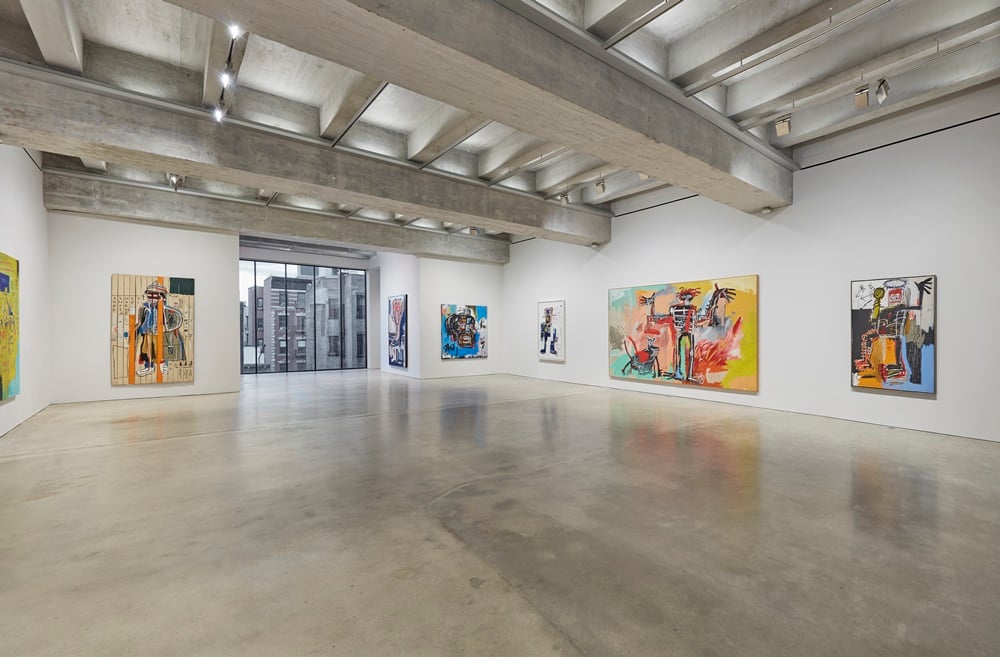
Is it ironic or fitting that a major survey of Jean-Michel Basquiat’s gritty, grafitti-style works just opened in Manhattan’s East Village to debut the multimillion-dollar new Brant Foundation?
On the one hand, this area of downtown Manhattan represented a fertile stomping ground for the artist during his meteoric rise to fame in the 1980s, And top collector Peter Brant—who says he sought a New York City space for his eponymous Greenwich-based foundation for years—has been a longtime champion of Basquiat’s art-historical importance (and market). At this morning’s press preview, Dieter Buchhart, the show’s curator, spoke at length about Basquiat’s connection to the neighborhood, how it inspired his work, and why it was such a fitting venue for the first show.
On the other hand, the stunning, cavernous space—a former Con Edison power plant that more recently served as artist Walter De Maria’s studio—has been converted into a private museum by architect Richard Gluckman as a function of Brant’s enormous wealth. (He scooped up the four-story, 16,000-foot property for roughly $25 million in 2014.) It has now been comprehensively overhauled, complete with exterior landscaping, a private enclosed driveway, and a rooftop terrace with a recessed water-filled skylight pool wafting overhead in the top floor galleries.
And it’s hard to ignore this luxurious setting’s disconnect from its immediate surrounding neighborhood—viewable through the floor-to-ceiling windows that punctuate the galleries—and the subject matter of Basquiat’s art itself, which frequently delved into issues of racism, poverty, inequity, and social injustice.
Installation view of “Jean-Michel Basquiat” at the Brant Foundation. Images: Tom Powel Imaging ©Estate of Jean-Michel Basquiat. Licensed by Artestar, New York. Courtesy The Brant Foundation
But none of that incongruity has dampened the enthusiasm around the show—and perhaps its free admission helps counter the reality that culture is increasingly governed by the über-wealthy. Basquiat, meanwhile, is about as popular as it gets when it comes to contemporary art audiences. Roughly 60 percent of the works in this 70-piece show are fresh off the blockbuster Basquiat survey that just wrapped up at the Louis Vuitton Foundation in Paris, which Buchhart also co-curated, and some have never been seen in New York before. Others will be familiar to anyone who has been following Basquiat’s art-market ascendance in recent years, in particular Untitled (1982), the large skull painting that Japanese billionaire Yusaku Maezawa acquired for $110.5 million at Sotheby’s in 2017, and which has been on a world tour including a stop at the Brooklyn Museum last year.
Installation view of “Jean-Michel Basquiat” at the Brant Foundation. Images: Tom Powel Imaging
©Estate of Jean-Michel Basquiat. Licensed by Artestar, New York.
Courtesy The Brant Foundation
The art in the Basquiat show includes many works from Brant’s foundation together with loans from the collections of Eli and Edythe Broad, Mia and Patrick Demarchalier, the Whitney Museum, Bruno Bischofsberger, François Pinault, Dimitri Mavrommatis, and several unidentified private collectors. The foundation says more than 50,000 people have already signed up online for the free admission tickets, which will permit entry at specified time slots after the show officially opens to the public on March 6.
Pointing to Untitled (1981), a large skull work on loan from the Broad Collection that bears similarities to the one bought by Maezawa, Buchhart called it one of the artist’s first masterpieces. “It shows the human head and human anatomy—he rips off the flesh and shows what’s below,” the curator said during a tour of the show. “Don’t forget he was facing racism every day. He couldn’t even hail a cab. It was a very frightening time.”
Buchhart also drew attention to Irony of a Negro Policeman (1981), which illustrates Basquiat’s belief that it was inherently paradoxical for a policeman to be African American. “You will find a lot of questions about black identity in the works,” he said.
Rooftop of the Brant Foundation’s new East Village space. Photo by The Brant Foundation’s new branch in Manhattan. Photo by Sean Keenan
Other paintings focus on popular culture and some of Basquiat’s heroes, such as Charlie Parker and the boxers Sugar Ray Robinson and Muhammad Ali. A stunning grid of stretcher-bar paintings on the second floor forces viewers to pause and look up to the double-height ceilings just to take it all in. It might all be a little bit overwhelming, says Buchhart, “but that’s the intention,”
For his part, Peter Brant, surveying the exhibition in his new private art space, seemed moved anew by the work on display. “Even 30 years after his death, Basquiat’s complex oeuvre has made him one of the most important innovators in modern art,” he said.
As for the dramatic site of the exhibition itself, Brant recounted that he had been tipped to the East 6th Street building several years ago when he ran into Dia founder Heiner Friedrich, who mentioned the property was available. (Artist Walter De Maria, who had used it as a studio and lived in a small upstairs room for decades, passed away in 2013). Said Brant: “We’ve always wanted to have a presence in New York, and thought this would be a perfect spot.”